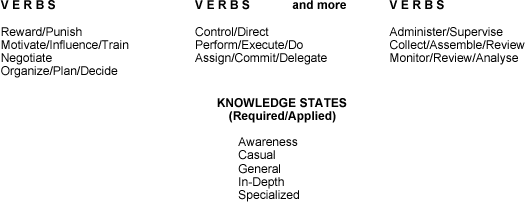What Does the PMrBoK Customer Do?
The next step is to describe just what it is this practitioner does. Perhaps the easiest way is to present a selection of verbs as requisites or prerequisites. Once this is established we can discuss the doing of the work and the resources required for execution. Finally the pattern of effort and activities in which our practitioner engages may be describable.
I have made a first pass at generating my preferred content for these areas as follows:

PM practitioners apply the knowledge represented by these verbs to the PM functions and considerations described below:
I. Goals and Aims Hierarchy
The practitioner establishes a hierarchy of goals and aims as follows:
II. The Environment
These goals are pursued in an environment characterized by the following arenas or influences:
- Corporate environment
- Client environment, including the client's business case or purpose for the project
- Resource supply and demand
- Regulatory constraints
- Social demands
o Community attitudes; and the
- Political environment.
III. Resource Consumption
The project will be executed, i.e. produce its product, within the demands of the environment described in II above. In doing so, it will consume resources consisting of the following types:
- Involved with or otherwise needed for the project
- Generated, consumed, used repeatedly/one time and on a full/sporadically/patterned basis
- Possible substitutes noted as to nature and equivalency
- Space/support requirements assigned or implied in resource use as appropriate
And these may be variously identified as:
- Time/Money/Access to Money
- Data/Information/Intelligence
- Talent/People/Equipment/Tools/Supplies/Temporary Materials
- Permanent Material/Permanent Equipment
- Space/Facilities/Capabilities.
Further, these resources may also have a conditional attribute. This is particularly important and useful in planning, scheduling and reporting. The following conditional status attributes are typical:
- Availability: Location as of; ordered; on tap where needed; en route; unobtainable; assembled; installed; tested; repaired; require training; etc.
IV. Purpose Sequence
In this and the following grouping, reading from left to right and then down, will provide an insight into the intent. The management of the application of the above resources may track as follows:
V. Status Measurements
In pursuing the above paths, measurements are taken periodically, as the project progresses, to permit display of status and trends using the following "as-at-time-now" metrics:
VI. Actual to plan comparison
Next is the evaluation of the comparison of the position as-at-time-now and the corresponding target value:
|



